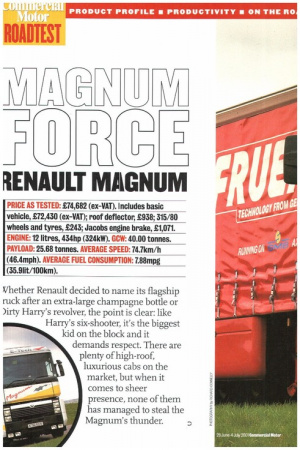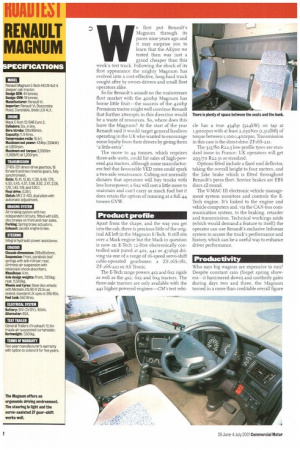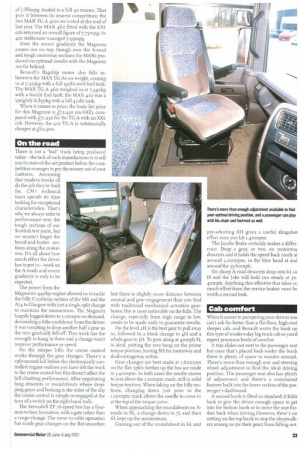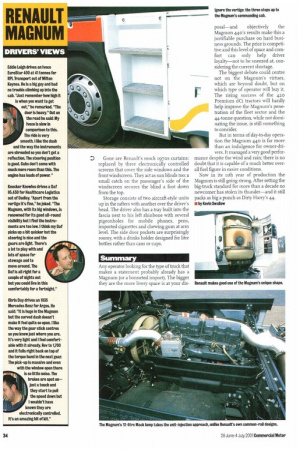RENAULT MAGNUM
Page 30

Page 32

Page 33

Page 34

If you've noticed an error in this article please click here to report it so we can fix it.
PRICE AS TESTED: £74,682 (ex-VAT). Includes basic vehicle, £72,430 (ex-VAT); roof deflector, £938; 315/80 wheels and tyres, £243; Jacobs engine brake, £1,071.
ENGINE: 12 litres, 434hp (324kW). GCW: 40.00 tonnes.
PAYLOAD: 25.68 tonnes. AVERAGE SPEED: 74.7km/h (46.4mph). AVERAGE FUEL CONSUMPTION: 7.88mpg
(35.91it/100km).
Vhether Renault decided to name its flagship ruck after an extra-large champagne bottle or )irty Harry's revolver, the point is clear: like Harry's six-shooter, it's the biggest kid on the block and it demands respect. There are plenty of high-roof, luxurious cabs on the market, but when it comes to sheer presence, none of them has managed to steal the Magnum's thunder. iAre first put Renault's Magnum through its paces nine years ago and it may surprise you to learn that the AE5oo we tested then was just a grand cheaper than this week's test truck. Following the shock of its first appearance the mighty Magnum has evolved into a cost-effective, long-haul truck sought after by owner-drivers and small fleet operators alike.
So far Renault's assault on the mainstream fleet market with the 400hp Magnum has borne little fruit—the success of the 42ohp Premium tractor might well convince Renault that further attempts in this direction would be a waste of resources. So, where does this leave the Magnum? At the start of the year Renault said it would target general hauliers operating in the UK who wanted to encourage some loyalty from their drivers by giving them -a little extra".
The move to 44 tonnes, which requires three-axle units, could hit sales of high-powered 4x2 tractors, although some manufacturers feel that favourable VED rates could spark a two-axle renaissance. Cubing out normally dictates that operators will buy trucks with less horsepower; a 6x2 will cost a little more to maintain and can't carry as much fuel but it does retain the option of running at a full 44 tonnes GVW.
Product profile
Apart from the shape, and the way you get into the cab, there is precious little of the original AE left in the Magnum E-Tech. It still sits over a Mack engine but the Mack in question is now an &Tech i2-litre electronically controlled unit (rated at 401, 441 Or 472hp) driving via one of a range of i6-speed servo-shift cable-operated gearboxes: a ZE.t6S-t8r, ZFAS-221 or AS Tronic.
The E-Tech range powers 4x2 and 6x2 rigids as well as the 4x2, 6x2 and 63(4 tractors. The three-axle tractors are only available with the 441 higher-powered engines—CM's test vein
cle has a true 434hp (324kW) on tap at 1,900rpm with at least 2,o5oNin (45121bit) of torque between 1,100-1,400rpm. Transmission in this case is the direct-drive ZFI6S-221.
The 315/80 R22.5 low-profile tyres are standard issue in France; UK operators will get 295/70 R22.5s as standard.
Options fitted include a fixed roof deflector, taking the overall height to four metres, and the Jake brake which is fitted throughout Renault's press fleet. Service brakes are EBS discs all round.
The V-MAC III electronic vehicle management system monitors and controls the ETech engine. It's linked to the engine and vehicle computers and, via the CAN-bus communication system, to the braking, retarder and transmission. Technical workings aside (which would demand a feature to itself) the operator can use Renault's exclusive Infomax system to access the truck's performance and history, which can be a useful way to enhance driver performance.
Productivity
Who says big wagons are expensive to run? Despite constant rain (forget spring showers—it hammered down) and northerly gales during days two and three, the Magnum turned in a more than creditable overall figure
of 7.88mpg, loaded to a full 4o tonnes. That puts it between its nearest competitors; the two MAN TG-A 4x2s we tested at the end of last year. The MAN 460 fitted with the XXL cab returned an overall figure of 7.75mpg; its 410 stablemate managed 7.mpg.
Over the severe gradients the Magnum comes out on top; though over the A-road and tough motorway sections the MANs produced exceptional results with the Magnum not far behind.
Renault's flagship motor also falls inbetween the MAN TG-As on weight, coming in at 7,325kg with a full 55olit steel fuel tank. The MAN TG-A 460 weighed in at 7,540kg with a 600lit fuel tank; the MAN 410 was a sprightly 6,897kg with a full 4rolit tank.
When it comes to price, the basic list price for this Magnum is £72,430 (ex-VAT), compared with £71,250 For the TG-A with an XXL cab. However, the 410 TG-A is substantially cheaper at £62,500.
On the road
There is not a "bad" truck being produced today—the task of each manufacturer is to sell you its state-of-the-art product before the competition manages to pry the money out of your mattress. Assuming that modern trucks all do the job they're built for, CM s technical team spends its time looking for exceptional characteristics. That's why we always refer to performance over the tough sections of our Scottish test route, but I we mustn't forget the bread-and-butter sections along the motorway. It's all about how much effort the driver has to put in—work on the A-roads and severe gradients is only to be expected.
The power from the
Magnum's 44ohp engine allowed us to tackle the hilly Cumbrian section of the MG and the A74 to Glasgow with just a single split change to maintain the momentum. The Magnum happily lugged down to toroorpm on demand, demanding a little confidence from the driver: it was tempting to drop another half a gear as the revs gradually fell off. This truck has the strength to hang in there and a change won't improve performance or speed.
On the steeper hills the cruise control works through the gear changes. There's a split-second lull before the electronically controlled engine realises you have left the work to the cruise control but this doesn't affect the hill climbing performance. After negotiating long descents or roundabouts where dropping gears and braking is the order of the day the cruise control is simply re-engaged at the turn of a switch on the right-hand stalk.
The Servoshift ZF 16-speed box has a fournext-to-four formation, with a gate rather than a range-change. The move to cable operation has made gear changes on the flat smoother but there is slightly more distance between neutral and gear engagement than you find with traditional mechanical actuation gearboxes; this is most noticeable on the hills. The change, especially from high range to low, needs to be made early to guarantee results.
On the level 2H is the best gear to pull away in, followed by a block change to 4H and a whole gear to H. To purr along at 4omph is ideal, putting the revs bang on the prime torque position, leaving 8H for motorway and dual-carriageway action.
Gear changes are best made at i,Goorpm on the flat; splits further up the box are made at 1,400rpm. In both cases the needle moves to just above the Lroorpm mark, still in solid torque territory. When taking on the hilly sections, changing down just prior to the 1,roorpm mark allows the needle to come in at the top of the torque curve.
When approaching the roundabouts on Aroads in 8L, a change down to 7L and then 6L kept up the momentum.
Coming out of the roundabout in 6L and pre-selecting 6H gives a useful slingshot effect once you hit 1,400rpm.
The Jacobs Brake certainly makes a difference. Drop a gear, or two, on motorway descents and it holds the speed back nicely at around 2,000rpm, in the blue band at and around the 55-6omph.
On sharp A-road descents drop into 6L or H and the Jake will hold you steady at 30. 4omph. Anything this effective that takes se much effort from the service brakes must be worth a second look.
Cab comfort
When it comes to pampering your drivers you can't ask for better than a flat-floor, high-roof sleeper cab, and Renault wrote the book on this type of modern-day big truck cab so you'd expect premium levels of comfort.
A tray slides out next to the passenger seat but once that's placed back under the bunk there is plenty of space to wander around. There's more than enough seat and steering wheel adjustment to find the ideal driving position. The passenger seat also has plenty of adjustment and there's a convenient footrest built into the lower section of the passenger's dashboard.
A second bunk is fitted as standard; it folds back to give the driver enough space to get into the bottom bunk or to move the seat further back when driving.However, there's no netting on the top bunk to stop the sleepwalkers among us (or their gear) from falling out.
Gone are Renault's mock 19705 curtains; replaced by three electronically controlled screens that cover the side windows and the front windscreen. They act as sun blinds too; a small catch on the passenger's side of the windscreen secures the blind a foot down from the top.
Storage consists of two aircraft-style units up in the rafters with another over the driver's head. The driver also has a tray built into the fascia next to his left shinbone with several pigeonholes for mobile phones, pens, imported cigarettes and chewing gum at arm level. The side door pockets are surprisingly roomy, with a drinks holder designed for litre bottles rather than cans or cups.
Summary
Any operator looking for the type of truck that makes a statement probably already has a Magnum (or a bonneted import). The bigger they are the more livery space is at your dis posal—and objectively the Magnum 440's results make this a justifiable purchase on hard business grounds. The price is competitive and this level of space and comfort can only help driver loyalty—not to be sneezed at, considering the current shortage.
The biggest debate could centre not on the Magnum's virtues, which are beyond doubt, but on which type of operator will buy it. The rising success of the 420 Premium dCi tractors will hardly help improve the Magnum's penetration of the fleet sector and the 44-tonne question, while not dominating the issue, is still something to consider.
But in terms of day-to-day operation the Magnum 440 is far more than an indulgence for owner-drivers. It managed a very good performance despite the wind and rain; there is no doubt that it is capable of a much better overall fuel figure in easier conditions.
Now in its iith year of production the Magnum is still going strong. After setting the big-truck standard for more than a decade no newcomer has stolen its thunder—and it still packs as big a punch as Dirty Harry's 44.
• by Kevin Swallow








































































































